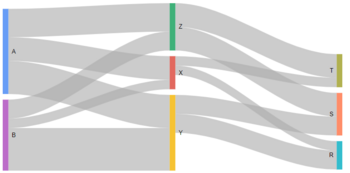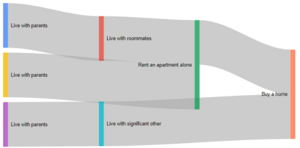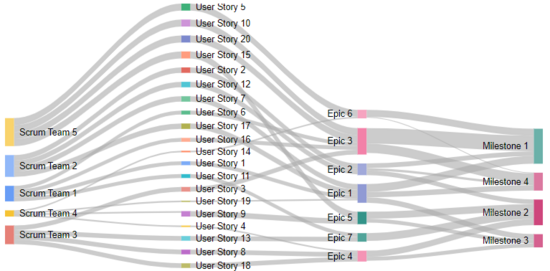Sankey Diagram
By Sonia Guerra Loji (s203379)
The article's aim is to highlight the usefulness of the Sankey diagram in a project & portfolio management context. The article includes a discussion of the diagram's pros and cons from the Managements perspective.
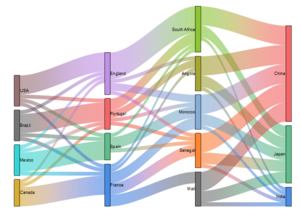
Contents |
Abstract
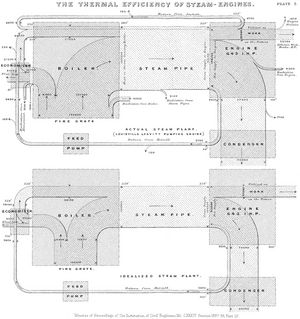
Beginning in 1898, the Sankey diagram was first used by an Irish captain named Matthew Henry Phineas Riall Sankey. This first implementation of the diagram showed the energy efficiency of a steam engine. [2] Nowadays there are four main implementations of the Sankey diagram. First, to analyze flow, flow being whatever has movement (like resources) in the scope defined by the diagram. Second, to analyze time-based patterns, this type can visualize the behavioral change of a specific persona, group, thing, over a specific time-lapse. Third, to analyze hierarchy type data, this is used when there are connected relations between the data but a hierarchy between the data has been defined. This hierarchy defines the order in which the data will be split and mapped in the diagram. And finally, the "quick trick" to replace Machine-learning, the Sankey diagram can be used to find and understand patterns in the data instead of using machine learning. [4] All four applications of the Sankey diagram can produce valuable insights to data in a visual and straightforward way to understand.
Correct application and automation of the Sankey diagram can provide fast and easy access to complicated data. The purpose of the article is to dive further into the possible applications and key characteristics of the Sankey diagram, as well as the benefits and limitations it can bring to upper management when making decisions in terms of resources and strategy.
Elements of the diagram
The Sankey Diagram is made up of five essential parts; this is flow, nodes, origin points, endpoints, and widths of the flow. As seen in the example diagram to the left, the nodes are identified by colored lines and letters. The nodes represent the activities, projects, people, etc. that are part of the visualized system. The flow of resources is visualized in the diagram by gray waves that connect the nodes, these gray waves widths represent the number of resources being passed from one node to another as well as the path the resources take through the system. This means that if the width of the gray wave is thin, few resources are being passed on to the next node. While if the gray wave is thick, a substantial number of resources are being passed on to the next node.
As mentioned previously the resources can be anything from money, human labor, materials, etc. The system as a whole can represent the flow of a process like a steam engine to the circulation of a global economy. For this reason, it is important to identify the origin points (where the system begins) and the endpoints (where the system ends). In the case of the example diagram, the origin points are nodes A and B, while the endpoints are nodes R, S, and T. In general terms the system flow should be read from left to right, and therefore when mapping the system's nodes the origin points should be towards the left extreme and the endpoints towards the right extreme. The Sankey Diagram can also show the equality or inequality between the inputs and outputs of the nodes. In the example diagram, it can be seen that node Z receives and gives the same flow, but nodes X and Y have a higher input than output. These visualizations of types of inequalities can help decision-makers notice areas of improvement faster. Depending on the program and style used to create the visualization, features like the color of the flow waves can be changed to resemble the color of the node it is originating from. Other more advanced features can be added to the code to create a more self-explanatory diagram, for the purpose of this article only the basic features are mentioned.
Another feature that is important to include in a Sankey Diagram is the system boundaries. The system boundaries represents the limitation of the process under study and can take a focus on spatial or temporal [5].
Types of Application
According to writer Pranay Dave, there are four main use-cases for a Sankey diagram [4]. Depending on the use-case, the diagram can visualize simple flows as well as aid in advanced analytics. Dave's main observation of the Sankey diagram is that it can be a powerful visualization tool if and only if it is used in the correct context and purpose.
His reasoning for this is that a visualization tool used incorrectly can serve little purpose and provide little to no insight to the user. An example he uses in his article to explain the incorrect use of diagrams is that of using a bar chart to visualize sales trends. Even though the bar chart can provide insight, a trend line chart could more effectively represent the changes in sales trends over the years. Under this logic, Dave has defined four use-cases in which it makes sense to use a Sankey Diagram.
Analyzing Flow [4]

In a project/program/portfolio scenario such as a construction project, project managers need to be aware of how much product is being used and wasted in each activity. For example, in some construction firms, cement mixing is done directly on the ground while others invest in concrete mixers with a revolving drum. Calculating which method is more efficient in time and which creates the least amount of waste can make a significant difference to the overall budget of the project when quantities of a product are heavily used. The Sankey diagram can also visually represent the amount of waste created throughout the entire process by adding to the waste at each step of the way and summing it at the end of the process.
Analyzing Time-Based patterns [4]
Sankey diagrams can also be used to identify time-based patterns. Author Dave describes this approach as understanding the customer's journey through time. In this example, the Sankey diagram represents a person's living quarters choices. Depending on the life path the individual is in, he/she can choose to move out of their parent's home to live with a roommate, a significant other, or alone. As life progresses the individual sharing his living quarters can decide to rent or buy his own place.
Companies typically create personas to identify who their potential clients are and what their needs and wants are. In many cases, the studies go as deep as to simulate the personas' decision-making pattern. The Sankey diagram in a time-based perspective can visually show the pattern trail personas typically take. This creates a roadmap for companies to target people that fit into the persona identity with products depending on the stage of the pattern trail they are at that moment. For example, someone that has just moved out of their parent's home doesn't have a lot of money to spend on furniture, so IKEA starts targeting that person with their affordable and stylish furniture. In comparison with someone that has been living on their own for a while and has greater purchasing power, they would like to invest in something more permanent. In that case, a company like Jacobsen could target this potential buyer as this person is now at a stage where this would be considered a reasonable purchase as opposed to when they first moved out of their parent's home.
In terms of a project application, managers can apply a Time-based Sankey Diagram to predict how their team is doing based on previous project experiences. Understanding the behavioral patterns of those in the project team can allow the manager to predict and prevent scope creep and/or project failure. By analyzing previous projects' End of Project Reports managers can identify the best practices and retrospectives, with this they can plan by identifying patterns and visually mapping likely routes of project progression according to the team's behavior and decision making.
Analyzing Hierarchy type data [4]
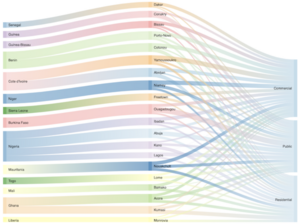
Quick trick to replace Machine-learning [4]
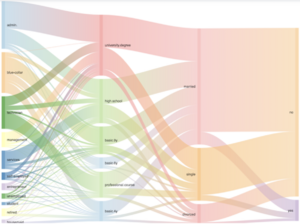
The idea that the Sankey diagram can represent a visual embodiment of the machine learning analysis is not so crazy when the data is not too extensive. In Dave's example, a bank has gathered information about the individuals they send marketing campaigns to. The point of the analysis is to identify which type of individuals are more likely to respond to marketing and who are less likely. The analysis involved the individual's occupation, level of education, marital status, and whether they responded to the marketing campaign or not.
Even though Dave creates an interesting point of discussion by proposing to replace machine learning with a simpler Sankey diagram, I would have to disagree with him to an extent. It is true that the diagram can visualize the flow between the different customer attributes and analyze that most customers do not respond to the marketing. But there is one big flaw when using a Sankey diagram instead of machine learning, that is that we cannot trace back from those that did respond to the marketing to which were the attributes that contributed to this answer. One of the major flaws of the Sankey diagram is that there is no way of tracing back your steps from the endpoint to the origin point. This is because the diagram is made in such a way that the number of resources that are input into a node are then redistributed when inputting them into another node.
For example, in the image, it is shown that most of those that responded to the marketing campaign are married. But out of those that we know that are married how many had university degrees, high school degrees, or basic education? The answer is inconclusive, as the diagram cannot clearly define where those married individuals came from. In conclusion, if the bank wanted to analyze the data to identify which type of people responded better to their marketing campaign this approach is not optimal and they would be better with using machine learning. But if their goal is to only visualize the general consensus of who and who many were targeted and responded to then the Sankey diagram is a clever way to understand your data.
Example in Portfolio Management
The main purpose of the Sankey Diagram is to visualize the flow of resources quickly and easily. This section will focus on how a Sankey Diagram can be useful in a Portfolio management case. First, there is a need to define some basic terminology used in a Technology Portfolio as this example is based on one.
As many companies have transitioned from a traditional Waterfall methodology where actions are dependent on other actions to an Agile methodology where actions can be done in parallel, a new terminology like Epics and User Stories have been introduced [6]:
- Stories, "also called "User Stories," are short requirements or requests written from the perspective of an end-user."
- Epics, "are large bodies of work that can be broken down into a number of smaller tasks (called stories)."
- Milestones, "are collections of epics that drive toward a common goal."
In a Technology Portfolio, Scrum Teams are formed to tackle the Stories and Epics. A Scrum Team is "typically between five to nine individuals, who work toward completing projects and delivering products. The fundamental scrum team comprises one Scrum Master, one Product Owner, and a group of developers."[7].
In a Technology Portfolio, the head of the portfolio must be able to assess the status of all projects within the portfolio at any given time. This means that all activities must be accounted for and must align with at least one of the milestones of the portfolio. Tasks that do not align with a milestone do not add value and therefore are considered a waste of resources. At the same time, a Portfolio Manager can compare the planned vs actual resource allocation as well as in what direction each Scrum Team is benefiting the bottom line of the portfolio. In the technology example, each Scrum Team works in individual User Stories, and the combination of the User Stories makes up an Epic. Meaning that even though each team works separately at the User Stories level they might be working together at an Epic level. From a manager's point of view, the diagram can raise red flags visually when User Stories or Epics are not getting the attention needed from the Scrum Teams. This red flag can create an alert for management that more resources are needed in a specific area. These resources could be the need for more Scrum Teams as the workload demands more people or that guidance from upper management is needed to steer the team towards the right direction. In many cases, as portfolios are so big and made up of many platforms with their own subdivisions, a clear view of what the portfolio is collectively working toward is unclear. A Sankey Diagram can serve as an overview dashboard for Portfolio Managers to quickly assess the status of the Portfolio and be able to make decisions for the future quarters. These decisions can be in increasing the workload through the creation of more User Stories and Epics as the teams can produce more, forecasting the number of people that need to be hired to meet deadlines, and refocusing on the milestones with the highest priority for the quarter. The current alternative, due to not having an overview, is that this information must be gathered by having individual meetings with the Scrum Teams to inform of their status and completion of tasks. This process is time-consuming for managers and can create major delays when decisions need to be taken by upper management.
Programing
Limitations
Conclusion
Annotated Bibliography
References
- ↑ "[1]", OriginLab (2021). 28.9.24 Sankey Diagrams. https://www.originlab.com/doc/Origin-Help/Sankey-Diagram
- ↑ 2.0 2.1 "[2]", Kennedy, A. B. W. (1898, January 1). The Thermal Efficiency of Steam Engines. Report of the Committee Appointed to the Council Upon the Subject of the Definition of a Standard or Standards of Thermal Efficiency for Steam Engines: With an Introductory Note. (Including Appendixes and Plate at Back of Volume). Zenodo. Retrieved February 12, 2022, from https://zenodo.org/record/2036163#.YiT1WujMK3B
- ↑ "[3]",Vosough, Z., Kammer, D., Keck, M., & Groh, R. (2018). Mirroring sankey diagrams for visual comparison tasks. Paper presented at the VISIGRAPP 2018 - Proceedings of the 13th International Joint Conference on Computer Vision, Imaging and Computer Graphics Theory and Applications, 3 349-355. doi:10.5220/0006651203490355 Retrieved from www.scopus.com
- ↑ 4.0 4.1 4.2 4.3 4.4 4.5 4.6 4.7 4.8 "[4]", Dave, P. (2022, January 15). 4 use-cases for Sankey Charts - Towards Data Science. Towards Data Science. Retrieved February 13, 2022, from https://towardsdatascience.com/4-use-cases-for-sankey-charts-679b94f7c672
- ↑ "[5]", Soundararajan, K., Ho, H. K., & Su, B. (2014, September 12). Sankey diagram framework for energy and exergy flows. ELSEVIER. Retrieved March 3, 2022, from https://pdf.sciencedirectassets.com/271429/1-s2.0-S0306261914X0019X/1-s2.0-S0306261914008812/main.pdf?X-Amz-Security-Token=IQoJb3JpZ2luX2VjECkaCXVzLWVhc3QtMSJGMEQCIGSuxA1sIgoTuFeNR6GX9YY4KfoWMfO2s%2FOx%2BV1WXiTPAiA%2BcOe15d143LamxslqF70JFQTS1htacokCK0aZX3Z8YyqDBAiS%2F%2F%2F%2F%2F%2F%2F%2F%2F%2F8BEAQaDDA1OTAwMzU0Njg2NSIMIzpUjRleKeZkLySZKtcDMg41%2F3unwoiJEc7CqRnfc%2F%2FDm%2B88Mkse510AKzkGLx%2FIyuvtbwhTYr%2Br6rLfbu5P3IzoXgb6i%2FPBWH8bzKyFYeILrpXPshLALhi%2FHO%2F0CPG5G0nBUMPLJEVFv4Xfj7AuzKunjh9aaYc2o1qoXL1EG%2BNTQfHHnV56%2BKbXam%2Bal5wS1csyEZx4xCIrl1%2F%2FhpbLofmRSvolf1a%2FY8efPUjWEcRwmw3eHWVCduy7bLHNRnl%2BX6jf81Ix6vyoqh4ss81rSNZsEknESDHFx7TmNdSFrPJY60TTcq5r9OT2ieyqd4RpISwim17ynpEf0u6Dbv5knB35QJ5Xzs5u4YacwLc5mZjrf%2F8klAtXxAX9HT9fXsb%2BTySrHGqXnO5VMcvDfnNhTOf80ISjeXo68gG5TpKkkM7HgdmNXCKM1Pz16cu2%2BF2TDiyM%2Fq6AcYkz8sC3ny0VVxtBdZNba1XtJwAL5iT3giRxJjJG3fR%2BpIt1g3HGu2K%2Bb8elAANDAOFblyQGDQTXTULOgW%2B5v2AwwJ7usZPvVM0ubxibk1DTnY7bT62zdEEEIKkSxZ1jewyTlMyMU12hCODMIk56EtPgR4KFOZ4S%2BEgjQkYHoZ1K%2FUy2otDaZ%2BIu%2F09hkqE%2FMLXJk5EGOqYB4UGjxIa6H6n3hYEsq9FAfhdC6o53X%2FhHDTKoOYHvlE2HyGUVmL6b3sZpfcPyYZ19IOdcqKfPePQ%2BeW27FhTHp%2F0180pQBunl9mGB%2FkJ3eEPLxOHiueofx4sVL3ld6g5l7drbxx%2FdFRzb93Xm8TlaKSVFzZbDxbHS%2FU9ijgUSpTuNnXX8LJRRNsoRyQN082%2BV0ffAnaklkIeqV1tKhZ3uGrFK262lFg%3D%3D&X-Amz-Algorithm=AWS4-HMAC-SHA256&X-Amz-Date=20220306T173619Z&X-Amz-SignedHeaders=host&X-Amz-Expires=300&X-Amz-Credential=ASIAQ3PHCVTYUUZN7OGY%2F20220306%2Fus-east-1%2Fs3%2Faws4_request&X-Amz-Signature=237277033185fe7fde9ec90da29c80d28d6371109358885478a8cacc2a850b7f&hash=a51b47eac5b95a2d4927228116e077fb609937c36997537075bfcd535a982244&host=68042c943591013ac2b2430a89b270f6af2c76d8dfd086a07176afe7c76c2c61&pii=S0306261914008812&tid=spdf-ee17f957-67d2-43ad-92d7-52796af33290&sid=46e2480c290a95453478d784a81b2811e994gxrqb&type=client&ua=570451010b01545903&rr=6e7cda56cae97367
- ↑ "[6]", Atlassian, & Rehkopf, M. (2022). Epics, Stories, Themes, and Initiatives. Atlassian. Retrieved February 20, 2022, from https://www.atlassian.com/agile/project-management/epics-stories-themes#:%7E:text=Stories%2C%20also%20called%20%E2%80%9Cuser%20stories,drive%20toward%20a%20common%20goal.
- ↑ "[7]", Indeed Editorial Team. (2021). A Guide to Scrum Teams. 20 February 2022
- ↑ "[8]", Google Charts. Sankey Diagram. 20 February 2022. https://developers.google.com/chart/interactive/docs/gallery/sankey
